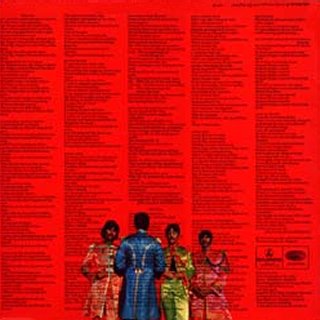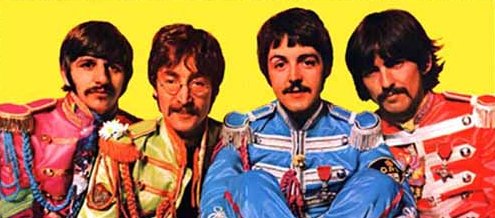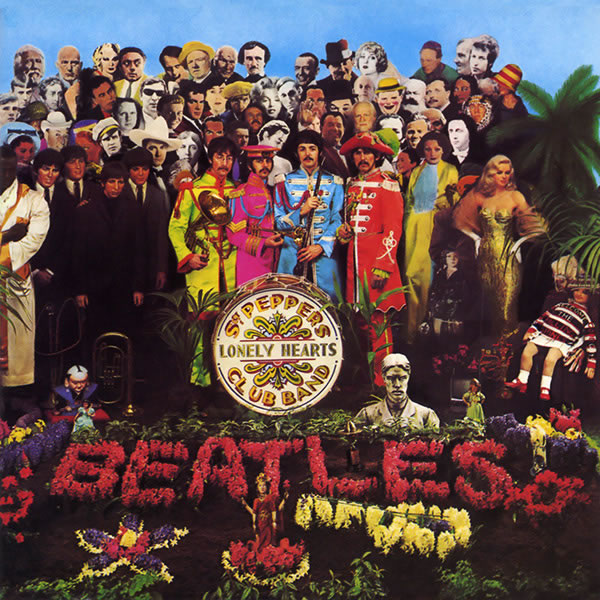|
Previous / Next
UK album |
 |
Sgt. Pepper's Lonely Hearts Club Band
First released: 1967, June 1 Buy
|
| Covers |
|---|



|
| Additional information | ||||||||||
|---|---|---|---|---|---|---|---|---|---|---|
Songs recording date and information:
The Run out Groove Recorded 21st April 1967, firstly, the endless nonsense for the run-out groove, Then between the final fade of "A Day in the Life" and "The Nonsense", a high-pitch whistle audible only to dogs was inserted. This was pitched at 15 kilocycles. On the CD version, "The Nonsense" lasts 22 seconds and fades! All songs recorded in studio two at Abbey Road except "Fixing a Hole", recording commenced at Regent Sound Studio, Tettemham Court Road, London. "Sgt. Peppers Lonely Hearts Club Band didn't start out life as a 'concept album' but it very soon developed a life of its own. I remember it warmly, as both a tremendous challenge and a highly rewarding experience. For me, it was the most innovative and trend-setting record of its time." - George Martin. "I was aware that new things were happening," says George Martin, "and I was very excited about it. I loved what the Beatles were doing and I was saying to them 'Let's have another session. Come up with more of these great ideas!'" Sgt. Pepper's Lonely Hearts Club Band was the Beatles' eighth album in a little over four years, release (unusually, on a Thursday) just a few days short of the fifth anniversary of the group's test/audition at Abbey Road studios. It would scarcely be an exaggeration to say that millions of words have been written about the LP, almost every one fulsome in its praise. But what surely stands out most of all is the Beatles' sheer progression to this point in time. Here were four musicians, raw and inexperienced in June 1962, changing popular music right about face by June 1967. With their astonishing fame, respect and talent the Beatles made Sgt. Pepper in a heady atmosphere when, to use the cliche, they could do no wrong, and at a time when they could do virtually anything and suceed. Paul McCartney conducting a 40-piece orchestra? No problem! "There's one thing they always used to say," remembers Phil McDonald. "'There's no such word as can't . What do you mean can't ?' The word just wasn't in their vocabulary. There was always a way around any problem. If they had an idea - any idea - they thought it must be possible to do it. That's how Sgt. Pepper was recorded." Sgt. Pepper's Lonely Hearts Club Band typifies the year of 1967 and, as such, must rank as a masterpiece, for surely the prime objective for any piece of music is that it captures the time of its recording. Part of the reason for this may be that 1967, in turn, influenced Sgt. Pepper itself. The clothes worn by the Beatles at the sessions would have made a splendid fashion parade. Drugs - the Beatles were using them more frequently during the recording of Sgt. Pepper than at any other time - also played a major role, expanding the imagination of four already very creative people. There was even psychedelic lighting inside studio two at Abbey Road, installed at the direct request of the Beatles. Well, sort of psychedelic anyway... "By 1967 the Beatles had become a little bit fed up with studio two at Abbey Road," says Geoff Emerick. "They'd been there for five years, with the plain plaster walls, wooden floor and the huge acoustic sheeting which hangs down there, full of dried seaweed! And the big white lamps in the ceiling were just too much. They asked if the studio could install some psychedelic lighting. Later that same day someone [studio electrician Harry Monk] came along and installed this strange contraption: three five-foot red fluorescent tubes on a microphone stand. I had a lava lamp and a red darkroom lamp at home so I brought them in to brighten up the control room. Then one of the Beatles brought in a stroboscope. I don't suppose they knew that strobes can have a dangerous effect if they're left on too long. Sure enough, after about five minutes of fun they all sat down feeling sick!" Keith Slaughter has an amusing postscript to this story. "George Harrison came into studio two at Abbey Road quite recently (1986) . He came up the stairs and said 'It's just like last time we worked here'. As was saying this he saw the fluorescent tubes and really burst out laughing, saying 'They're really still here!'" Had the Abbey Road studio personnel been given annual report cards like school student, a number would have benn branded 'abuse of equipment', for in their efforts to innovate at the direct request of the Beatles, people often fell foul of the unwritten studio rules. Geoff Emerick vividly recalls one occasion. "John wanted a really unusual vocal sound so I suspended a very thin condenser microphone tied in a plastic baf inside a milk bottle filled with water. Lennon was singing at the top of his voice at this bottle when the studio manager came in. 'What's that noise? How are you getting that?' I was terrified! We both stood around the bottle, shoulders at all angles, trying to hide it. "The Beatles would say 'We don't want the piano to sound like a piano, we want it to sound like a guitar. But we then want the guitar to sound like a piano.' We used to sit there thinking 'Well why play the wretched thing in the first place?' And we never had the luxury of 1980s gimmick boxes then, just ordinary tape machines." Jerry Boys, then a tape operator at Abbey Road, now a studio manager in his own right, sums up Sgt. Pepper's Lonely Hearts Club Band from a technical standpoint. "If you listen to the album, there are noises which are still impossible to make, even with today's computerised 48-track equipment and all the mimcrochips imaginable. It's a very very clever record. In terms of creative use of recording it has been on of the major steps forward." George Martin, Geoff Emerick and others involved on the production side of Sgt. Pepper were understandably aggrieved when they later read a John Lennon interview slating the LP. "John later said he thought Pepper was a terrible album," says Geoff Emerick. "He said something like 'We don't want to make another album like that rubbish!' which was a ridiculous comment." "John told me he was never satisfied with anything he'd done, Beatles or solo," says George Martin. "In one interview [ Rolling Stone 1970, published 1971] he was vicious to everybody, including me, for which I hardly ever forgave him. It was completely unqarranted. I met him in Hollywood in 1974 and spent an evening with him. I said 'I don't know if you want to see me, John' and he replied 'Oh, come on George! I was out of my head when I said a lot of those things. Take no notice of what I said.' It was a kind of apology which I was grateful for. But John was a strange person and he did change enormously from the early days." Quality and value for money were much on the Beatles' mind when Sgt. Pepper was issued. The record came in what was then a very novel, deluxe colour sleeve, with free cardboard cut-outs and the song lyrics printed in full - a first. The Beatles also posed for a special poster issued by their fan club and even had the publisher of their official monthly magazine use colour for the first time. And the Beatles insisted that the album be issued identically all over the world, even in the USA where Capitol Records fell into corporate line with the UK on a Beatles album for the first time. At one point Sgt. Pepper was even going to be pressed on coloured vinyl, recalls Tony Bramwell. "It would have been like one of those children's records from Woolworth's, with the splattered colours." Bramwell also remembers the original workng title of the LP: "'One Down, Six To Go', a joky reference to the new contract with EMI." It is contentious point that Sgt. Pepper's Lonely Hearts Club Band represented the Beatles' last real united push behind a project, and their last truly creative offering. Certainly after the LP had been completed the Beatles' recordings - throughout the remainder of April, all of May and early June, for example - did display a startling lack of cohesion and enthusiasm, as though they had injected their all into Sgt. Pepper and now wanted to take things easy. On this day, 1 June 1967, perhaps the most celebrated day in their career, the Beatles went into the studio and recorded nothing but untitled, unplanned, highly tedious and - frankly - downright amateurish instrumental jams, with a bass guitar, an organ, lead guitar with reverb, guitar strings being scraped, drums and tambourine. The single-minded channelling of their great talent so evident on Sgt. Pepper's Lonely Hearts Club Band did seem, for the moment, to have diappeared. - Mark Lewishon "The Beatles Recording Sessions" |
